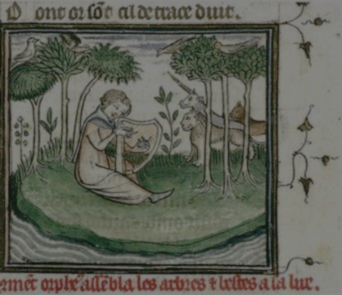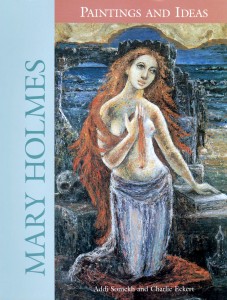One Mind Good Press offers a collection of written works authored and curated by master teacher, theatrical dramaturge, and literary scholar Gideon Rappaport.
Embracing Aristotle’s claim that art exists to provide both entertainment and instruction, One Mind Good Press makes available works intended to enhance readers’ appreciation of the illuminating vision of Shakespeare (and others), which offers authentic avenues of meaning amidst our cultural darkness of relativism, cynicism, and despair. The name of the Press comes from the words of the Jailer in Shakespeare’s Cymbeline (V.iv.203–204), who says, “I would we were all of one mind, and one mind good.” About OMGP >

Paradox
By Gideon Rappaport
Professor Mary Holmes called paradox “the natural condition of the world. It is both the working principle and the mystery of life… We are always surrounded by paradox because all of creation is the union of opposites. All energy comes from the union of opposites.” Holmes is here tying our experience of paradox to our consciousness of opposites. And her insight reminds us that though our human categories of thought are insufficient to contain all of reality, yet our experience of paradoxical contraries invites us to ask: What is the unity that binds these opposites into relation to one another, that reveals two mutual exclusives as paradoxically parts of one underlying reality? The following observations consider without finality some of the fundamental contraries that we human persons experience as paradoxes in contemplating ourselves and the world.

High School Homilies
By Gideon Rappaport
A collection of prepared talks, books and film reviews, letters to former students, and other pieces written during the period of thirty-two years during which Dr. Gideon Rappaport was teaching high school English and intermittently working as a theatrical dramaturge, mostly on productions of Shakespeare. This volume collects in Part I the chapel talks and speeches he gave at the two high schools at which he taught, in Part II his book and movie reviews, and in Part III other writings, including letters to former students and weblog posts.

Shakespeare’s Rhetorical Figures: An Outline
By Gideon Rappaport
When Shakespeare began writing for the stage, he had already mastered over two hundred rhetorical figures inherited from the long tradition of the language arts—grammar, logic, and rhetoric—stretching from Aristotle to his own time. These figures, which to us may appear merely decorative, were for Shakespeare the very medium of speech, and as his art developed, his figures became more and more subtly expressive of meaning.
Shakespeare’s Rhetorical Figures: An Outline provides convenient access to this crucial dimension of Shakespeare’s art. It includes all Shakespeare’s rhetorical figures in outline form, each accompanied by a definition and examples, and a cross-referenced alphabetical glossary.
Order Shakespeare’s Rhetorical Figures: An Outline >
What Is Being Said About Shakespeare’s Rhetorical Figures: An Outline
I’ve spent the afternoon poring over [Shakespeare’s Rhetorical Figures: An Outline] and delighting in it. We’ve always known that Shakespeare had studied the rhetoric prevalent in his day, but this massive compilation shows just how skillfully he made use of it. One gets the sense that he internalized the devices to such an extent that he could use them to strengthen his dramatic effects without appearing in the least pedantic; the rhetorical figures became a part of his own imagination, so that they seem natural to the characters who speak them. (That isn’t the case with a number of Elizabethan and Jacobean writers who went to the same school, so to speak.) The copious examples you present in this invaluable work underline his ability to turn rhetorical devices into expressions of character and drama. He wouldn’t have been Shakespeare without them!
– Jonathan Saville, Ph.D., Professor in Literature and Theater Departments at the University of California at San Diego, retired

William Shakespeare’s Hamlet
Edited and Annotated by Gideon Rappaport
This thoroughly annotated edition aims at nothing less than a radical restoration of the meaning of Hamlet.
Because not only particular words but also assumptions about the nature of reality have undergone significant changes between Shakespeare’s time and ours, modern scholars, play directors, and film producers have often wrenched this great play out of its intended meaning, obscuring its essential dramatic structure and leaving audiences and readers perplexed. This edition will help all students of the play to see that Hamlet offers an experience of profound meaning both entirely coherent and as relevant in our time as in its own.
Order William Shakespeare’s Hamlet >
What Is Being Said About William Shakespeare’s Hamlet: Edited and Annotated by Gideon Rappaport
“…Rappaport’s edition of Hamlet boldly realigns interpretation of the play with a critical tradition that values close reading, ponders moral questions that are universally applicable to human experience, and celebrates the achievement of great authors…[It] is the kind of achievement that requires a love of one’s subject no less than a commitment to finding the truth. As an editor and scholar, Rappaport demonstrates these qualities to a superlative degree.”
– Sean Keilen, Professor of Literature and Founding Director of the Shakespeare Workshop, University of California at Santa Cruz
“…Rappaport has given a ‘divine shaping’ to Shakespeare’s play by synthesizing centuries of sources and scholarship. His two-column format rewards our eyes and rewords our reading, making the long-since familiar something ‘wondrous strange’ again. Teachers and students, actors and directors alike will benefit from this loving labor of unfolding.”
– Scott Newstok, Professor of English and Director of the Pearce Shakespeare Endowment, Rhodes College, and author of How to Think Like Shakespeare: Lessons from a Renaissance Education
Watch Dr. Gideon Rappaport Discuss William Shakespeare’s Hamlet (youtube.com)


Appreciating Shakespeare
By Gideon Rappaport
Lifelong Shakespearean teacher-scholar Gideon Rappaport provides, for readers and playgoers of all ages, the essentials for understanding the ingenious wit and poetic wisdom of William Shakespeare.
Founded on the best scholarship, this book explores the intended meaning of Shakespeare’s works grounded in the historical and cultural context of the Renaissance. The book rounds out this experience by offering the tools of knowledge—about Shakespeare’s life, language, poetic and dramatic techniques, and theatrical context—so that the reader may understand and appreciate some of the greatest and most moving works in the English language.
Added to the sections of background knowledge, Appreciating Shakespeare offers short essays on twenty-two plays, pointing readers to the universally meaningful heart of each and illuminating themes often hidden or misrepresented in many stage and screen productions and critical writings. There is also a chapter dedicated to analysis of a selection of Shakespeare’s sonnets.
In an easily readable way, this work provides what is essential to know for deep appreciation of the timeless meanings in the plays without overwhelming readers with more information and literary argument than they need. It can be read straight through but also arranges the essentials according to the most commonly asked questions, making it easy for readers to pinpoint their areas of interest. Explore the Contents >
Order Appreciating Shakespeare >
What Is Being Said About Appreciating Shakespeare
“A brilliantly presented introduction to the literary excellence of Shakespeare in a format that will appeal to both students, academia, and non-specialist general readers alike, ‘Appreciating Shakespeare’ by Professor Gideon Rappaport is especially and unreservedly recommended for personal, professional, community, highschool, college, and university library Shakespeare collections and supplemental Drama/Poetry Literary Criticism curriculum studies lists.”
– Midwest Book Review
“Mr. Rappaport’s answer to the question, “What’s so great about Shakespeare?” is among the best I’ve ever seen, and sums up the spirit and focus of this book, a book that rises high above the petty politicizing into which so much literary criticism has fallen…”
– Walker Larson, The Epoch Times

Dusk And Dawn
Poems and Prose of Philip Thompson
This edition makes available to the public the poems and prose of the extraordinary poet, critic, and satirist Philip Thompson.
Dusk and Dawn consists mainly of those works that, at the time of his death in 1993, the poet considered finished and ready for publication. Also included are examples of poems and prose pieces from manuscript drafts left in various stages of completion, several autobiographical letters, and an autobiographical note. The editor has provided a literary introduction, a brief biographical sketch, notes, an index of titles, and an index of first lines.
Recommendations

This book records Mary’s observations about life and art in two ways – through her paintings and the stories they tell, and through her conversation about ideas she has been thinking and teaching about for over sixty years.
“This is a fascinating book about an amazing woman. I knew Mary Holmes on a personal level for more than thirty years and this book captures the ambiance of her fantastic personality.” – Ray Bradbury

Mary Holmes, a founding member of the faculty of the University of California, Santa Cruz, was a painter of mythic images and portraits and a moving, illuminating, and much beloved lecturer on the nature and history of art. In her teaching and in her paintings she gloriously fulfilled what she believed to be the purpose of all art: to make the invisible visible.
